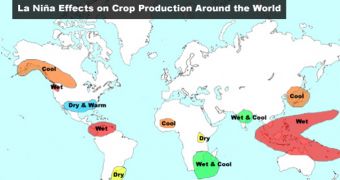Climate scientists warn that the new parameters of the La Nina atmospheric pattern could have significant repercussions on the world's crops, including corn, coffee, wheat and rice.
Crops in the American Midwest could decline significantly this summer, due to the phenomenon, and the state of Illinois could be plagued with drought conditions, that would replace its usual precipitation patterns.
Columbia's coffee bean production is already being harmed by the changes that La Nina is causing around the globe. Its effects reach from pole to pole, and generally last for a year, maybe more.
Researchers keeping an eye on the tropical Pacific Ocean usually announce that the atmospheric pattern has set in when water temperatures in the areas become significantly cooler than normal. When the colder waters move into warmer ones, they produce changes in the atmosphere that span the planet.
“We are currently in a pretty severe La Nina. Unfortunately, with a La Niña, there’s a lot of uncertainty as to how long this is going to persist,” explains University of Illinois in Urbana-Champaign (UIUC) plant biologist Carl Bernacchi.
“Depending on how one exactly measures La Nina, and there are several different indices used, the current La Nina began around May of 2010. Most forecasts show the La Nina persisting at least through the spring,” adds Chris Hennon.
He holds an appointment as a professor of atmospheric sciences at the University of North Carolina (UNC). The expert explains that the weather pattern will make itself noticed in the Pacific Northwest, which is the area of the US generally most affected by the shifting water temperatures.
The Northwest tends to get increased amounts of precipitation whenever La Nina strikes. Conversely, the US South become drier than average. “If the La Niña event extends much longer than it has in the past there is a higher chance of drought” in Illinois, Bernacchi explains.
The issue with this particular state is the fact that irrigation and water-pumping systems are not so widely available as in other parts of the country. If drought hits, then crops would become especially vulnerable to failure.
“For the most part we’re going to forge ahead. One of the beauties of today’s corn is that it is able to withstand more stresses,” corn and soybean farmer Rob Elliott explains.
“There’s not a whole lot you can do. You’re at the mercy of the weather. One thing about the farm, you’ve got a lot invested and you’re at the mercy of mother nature,” he adds, quoted by the MEDILL news service.

 14 DAY TRIAL //
14 DAY TRIAL //